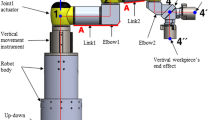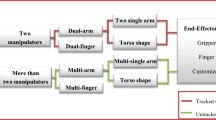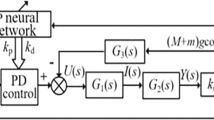Abstract
Aiming at the workspace calculation problem of multi-joint serial manipulators, a surface enveloping and overlaying (SEO) method is presented to identify and visualize the manipulator workspace. The SEO method is composed of two stages: the first stage is to choose reference points of the manipulator and calculate their boundary surfaces using the nth enveloping method; the second stage is to overlay these boundary surfaces to identify the final workspace. The SEO method is basically a combination of the analytic method and the numerical method. By delineating the graphic representation of the workspace step by step, the SEO method is easy to analyze the existence and the shape of voids and holes. The basic theory of the SEO method and formulas for workspace calculation are presented based on a 6R serial manipulator. By showing the workspace calculation results, the SEO method is proved working correctly.
Similar content being viewed by others
References
Litvin F L, Fanghella P, Tan J, et al. Singularities in motion and displacement functions of spatial linkages [J]. ASME Journal of Mechanism Transmission and Automation in Design-Transactions, 1986, 108(4): 516–523.
Litvin F L, Yi Z, Castelli V P, et al. Singularities, configurations, and displacement functions for manipulators [J]. International Journal Robot Research, 1986, 5(2):52–65.
Jo D Y, Haug E J. Workspace analysis of closed loop mechanisms with unilateral constraints [C]// in Proceedings of ASME Design Automation Conference. Montreal, Que, Candada: ASME, 1989: 53–60.
Litvin F L, Castelli V P. Configurations of robotic manipulators and their identification, and the execution of prescribed trajectories, part 1: Basic concepts [J]. ASME Journal of Mechanisms, Transmissions and Automation in Design, 1985, 107(2): 170–178.
Lipkin H, Pohl E. Enumeration of singular configurations for robotic manipulators [J]. ASME Journal of Mechanical Design, 1991, 113: 272–279.
Shamir T. Remarks on some dynamical problems of controlling redundant manipulators [J]. IEEE Transactions on Automatic Control, 1990, 35(3): 341–344.
Lai Z C, Yang D C H. A new method for the singularity analysis of simple six-link manipulators [J]. International Journal of Robotics Research, 1986, 5(2): 66–74.
Abdel-Malek K, Yang J Z. Workspace boundaries of serial manipulators using manifold stratification [J]. Inernational Journal of Advanced Manufacturing Technology, 2006, 28(11–12): 1211–1229.
Erika O, Manfred H, Marco C. Identification of the workspace boundary of a general 3-R manipulator [J]. ASME Journal of Mechanical Design, 2006, 128(1): 236–242.
Mazen Z, Philippe W, Damien C. An exhaustive study of the workspace topologies of all 3R orthogonal manipulators with geometric simplifications [J]. Mechanism and Machine Theory, 2006, 41(8): 971–986.
Wang Zhong-fei, Ji Shi-ming, Sun Jian-hui, et al. A methodology for determining the reachable and dexterous workspace of parallel manipulators [C]// Proceedings of IEEE International Conference on Mechatronics and Automation. Harbin, China: IEEE, 2007: 2871–2876.
Yang Jing-zhou, Abdel-Malek K, Zhang Yunqing. On the workspace boundary determination of serial manipulators with non-unilateral constraints [J]. Robotics and Computer-Integrated Manufacturing, 2008, 24(1): 60–76.
Lu Y, Shi Y, Hu B. Solving reachable workspace of some parallel manipulators by computer-aided design variation geometry [J]. Proceedings of the Institution of Mechanical Engineers. Part C: Journal of Mechanical Engineering Science, 2008, 222(9): 1773–1781.
Wang L Q, Wu J R, Tang D D. Research on workspace of manipulator with complicated constraints [C]//The 7th World Congress on Intelligent Control and Automation. Chongqing, China: IEEE, 2008: 995–999.
Choi C H, Park H S, Kim S H, et al. A manipulator workspace generation algorithm using a singular value decomposition [C]// International Conference on Control, Automation and Systems. Seoul, Korea: IEEE, 2008: 163–168.
Author information
Authors and Affiliations
Corresponding author
Rights and permissions
About this article
Cite this article
Wang, Xy., Ding, Ym. Method for workspace calculation of 6R serial manipulator based on surface enveloping and overlaying. J. Shanghai Jiaotong Univ. (Sci.) 15, 556–562 (2010). https://doi.org/10.1007/s12204-010-1048-5
Received:
Published:
Issue Date:
DOI: https://doi.org/10.1007/s12204-010-1048-5




